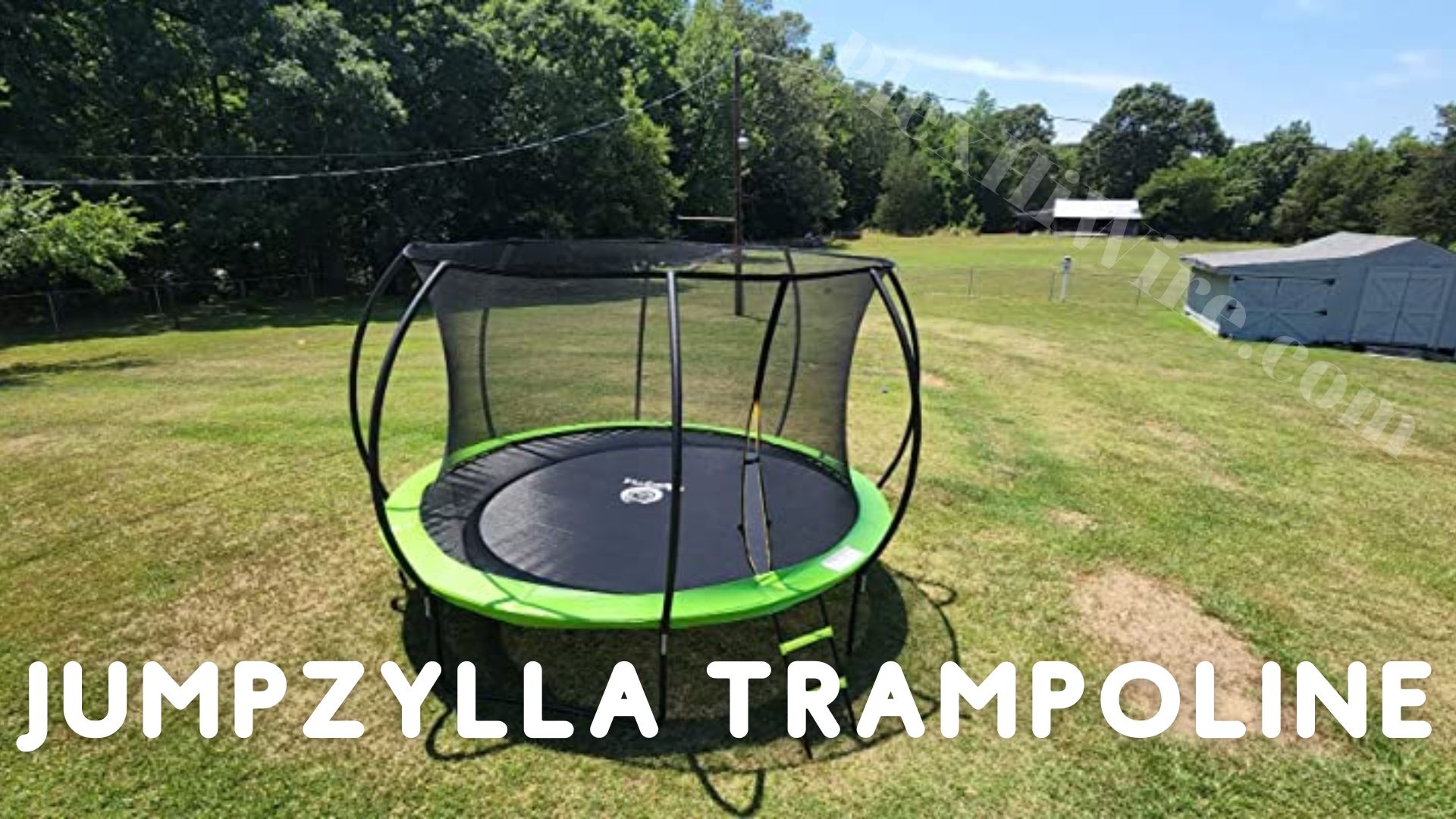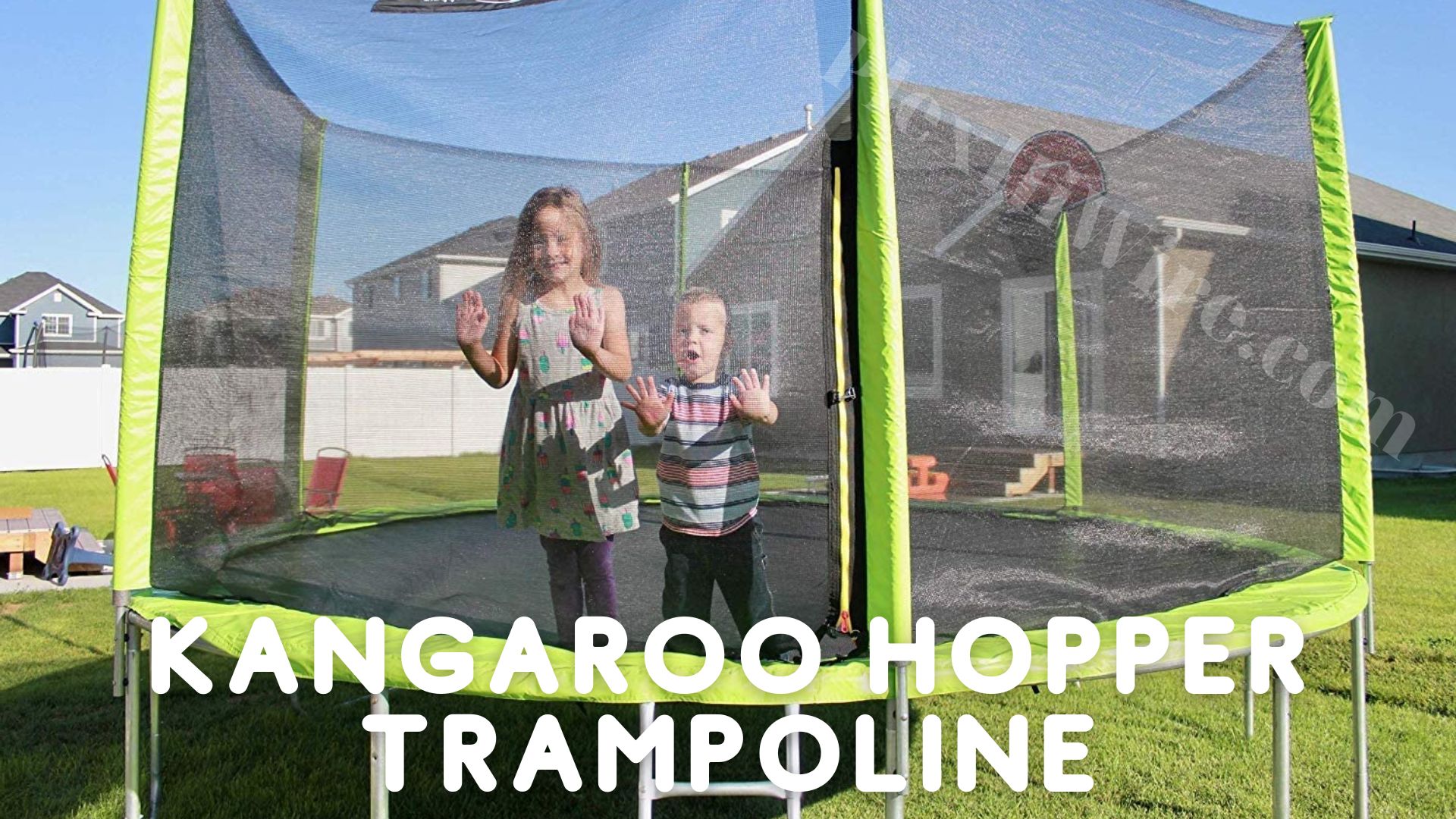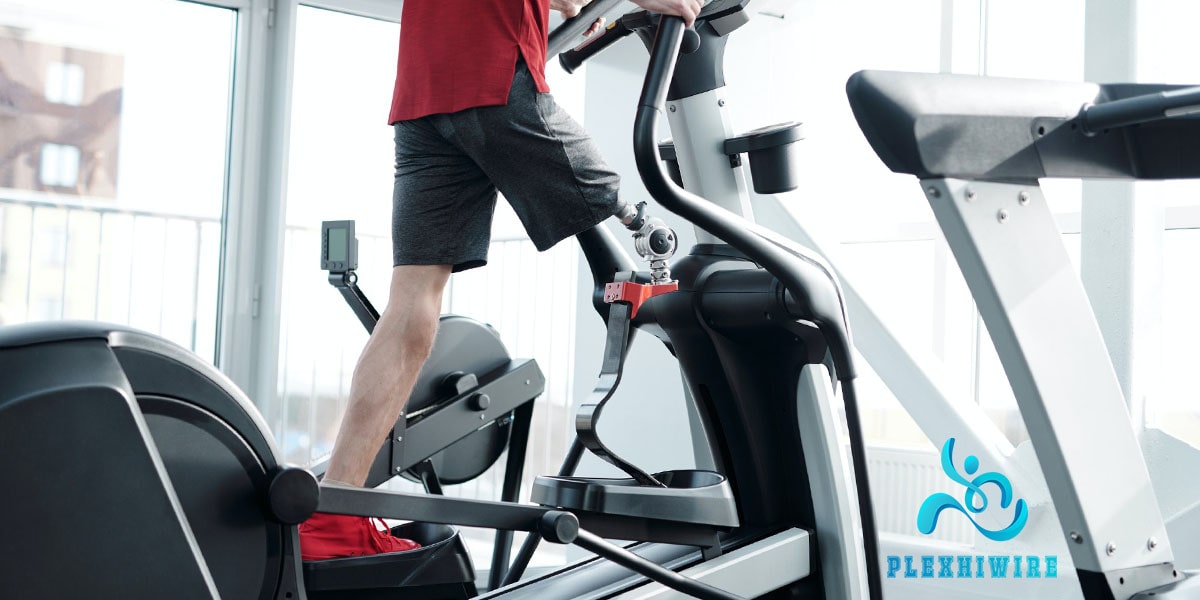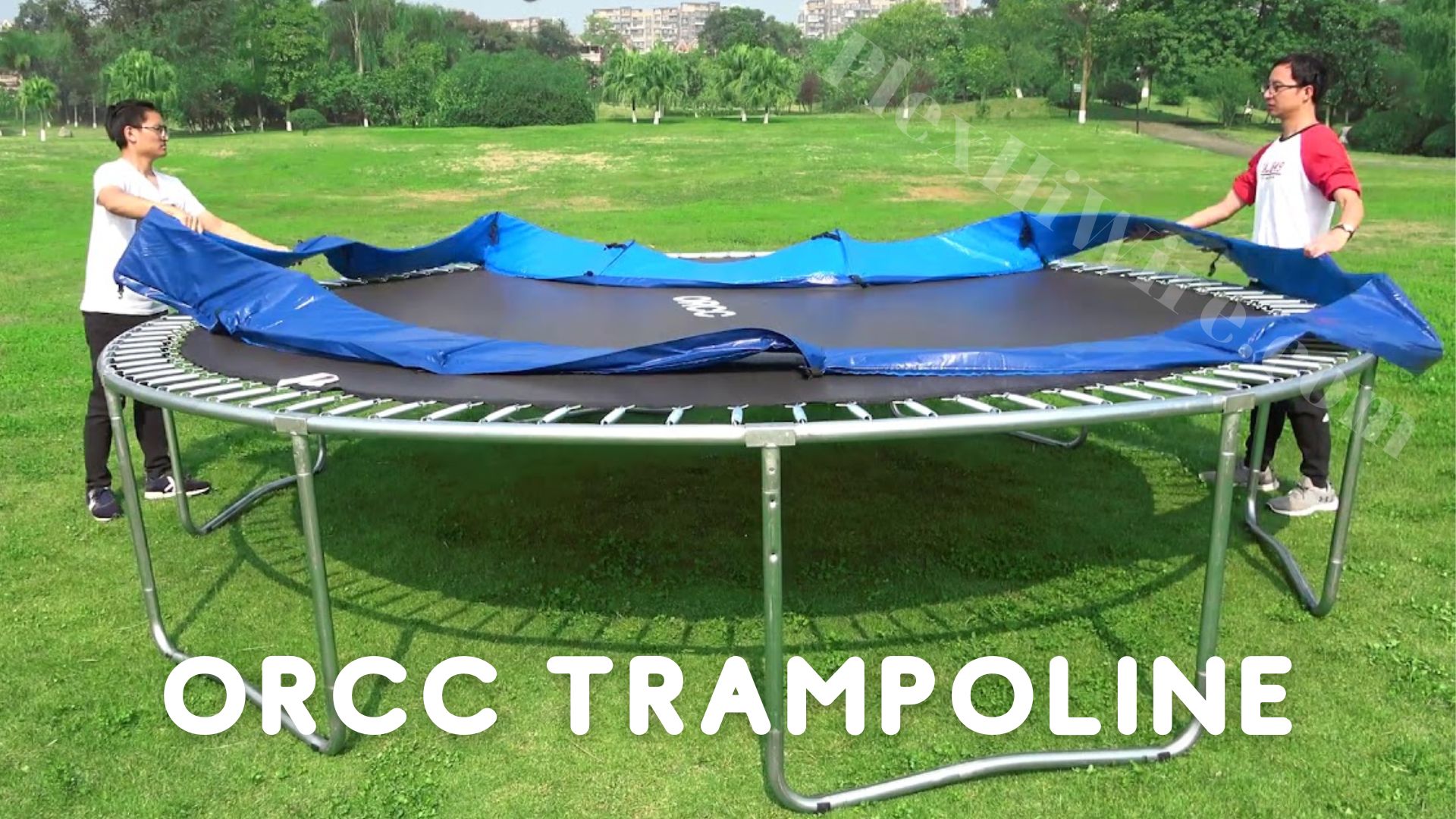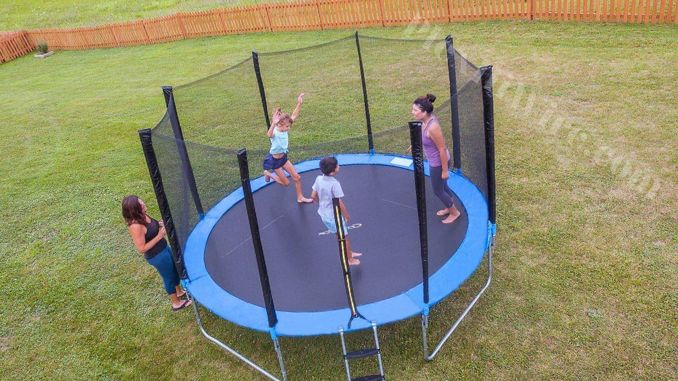What are Trampolines Made of?
As you also know, the trampoline is one of the most popular instruments today with a soft surface, is easy to use, and gives you high entertainment. It gives you a sense of comfort, but it is also a great exercise tool and one of the effective ways to lose weight.
One of the questions that many people are interested in when buying a trampoline is “what are trampolines made of?” Basically, it has many different parts, with each part having a different use and material. So, to learn about the material and uses of the trampoline, we must learn about the parts of the trampoline before it will help us to understand the whole process of forming it properly.
However, four main components make up a complete frame for a trampoline. Includes the jumping mat, springs, frame, and safety pad. Below I will provide you with the information that I know about these parts. What are their uses? To learn more about it, let’s find out with me.
See more: How Much Weight Can A Trampoline Hold?
- What are Trampolines Made out of?
- What are the Origin and Benefits of the Trampoline?
- The Main Components of a TrampoLine
- What is The Best Surface for a Trampoline?
- More about Springfree Trampolines
- How are Trampolines Made?
- The History of the Treadmill and Its Use in Prisons
- What are The Key Materials Used in Trampoline Manufacturing?
- What is The Difference Between Steel and Aluminum Trampolines?
- What Type of Fabric is Used in Trampoline Manufacturing?
- How Often Should I Replace My Trampoline Mat?
- What was The First Trampoline Made out of?
- What Type of Spring is Used in a Trampoline?
- What is a Trampoline Used for?
- What are Olympic Trampolines Made of?
- What are Mini Trampolines Made of?
- Frequently Asked Questions
- How many springs does a small trampoline have?
- How often should I inspect my trampoline?
- Conclusion
What are Trampolines Made out of?
Trampolines are made of a variety of materials, depending on the type of trampoline and its intended use. The most common type of trampoline is the outdoor recreational trampoline, which is typically made of galvanized steel for strength and durability. Springs are also made of steel, and the mat is usually made of nylon or PVC. Indoor trampolines are often smaller and may be made of different materials such as aluminum or steel tubing, with a mat made of softer materials such as PVC or polypropylene. Mini-trampolines, or rebounders, are usually made entirely of plastic. Competition-grade trampolines must meet certain specifications set by the International Gymnastics Federation and are usually made of aluminum for the frame and springs, with a mat made of hemp or wool. Whatever the materials, all trampolines share the common purpose of providing a fun and safe jumping experience.
What are the Origin and Benefits of the Trampoline?
The popular sport of trampolining has roots in the trademarked rebound tumbler. This dynamic exercise, which traces back to origins as a form of rebounding and tumbling, has since become its own unique entity without reliance on any particular corporation’s branding!
Trampolining is a physically and mentally stimulating activity that can provide a great workout while helping to build strength and coordination. It involves jumping, flipping, and somersaulting on a trampoline, using the momentum of the bounce to propel yourself into the air. Many people enjoy this exhilarating exercise, which makes it an excellent option for both competitive athletes looking to develop their skills or just those looking for a fun way to stay active.
Additionally, because trampolines use minimal space – usually about 10×10 feet – it’s easy to set up in most backyards or other small areas. Trampolining can be a fantastic activity for all ages, from children as young as two years old to adults of any age who want to get a good workout and have some fun! Trampolining is also becoming increasingly popular at gyms, parks, and other facilities, providing people with more opportunities to stay active. Whether you’re an experienced gymnast or someone just looking for a way to stay fit, this exciting sport has something for everyone. So give it a try – you won’t regret it!
Trampolining offers numerous health benefits that can help improve overall fitness and well-being. It increases heart rate and stamina while burning calories, helping to improve cardiovascular health and reduce the risk of obesity. This exercise also helps build strong muscles in both the upper and lower body as well as improving flexibility, coordination, balance and posture. Additionally, because trampolining is a low-impact activity, it’s easy on the joints, making it a good choice for those with existing injuries or joint pain. The feeling of weightlessness while jumping also can help to relieve stress and anxiety, promoting a sense of calmness and relaxation. Finally, because this sport involves jumping and flipping in midair, it can help improve self-confidence and provide a feeling of accomplishment that will give you an added boost!
Trampolining is an enjoyable activity that can be enjoyed by people of all ages. It’s a great way to stay physically active while having fun at the same time – so why not give it a try? With its numerous health benefits and opportunities for growth, trampolining can be a fantastic addition to any fitness routine. So get out there and start bouncing! You won’t regret it.
The Main Components of a TrampoLine
It is easy to see why trampolines are so popular. They’re not only simple in design but also fairly durable with their bouncing. Its quality and durability depend a lot on these quality and components used.
So, what are trampolines made of? The four main components of a trampoline are springs, frame, jumping mat, and safety pads. We’ll take you through each one in turn to give your understanding more teeth!
The Jumping Mat
The jumping mat is an essential part of any trampoline because it allows for the user’s weight when landing. What is a trampoline jumping mat made of? Made mostly out of polypropylene or nylon material, these surfaces have been designed to be strong enough while still being soft on your feet, so they don’t hurt after long jumps!
While the mat may seem like it’s responsible for giving you that bouncing effect, all they do is provide a sturdy and strong enough landing area.
The jumping mat is usually tied to the frame so that users can bounce up and down without risk. However, for large-scale uses, it’s best to invest in a fairly large nylon or polyethylene fiber-filled mat, which will provide more comfort while jumping as well as durability over time because these materials are less prone than others to moisture build-up due to their low absorbency properties.
You can quickly tell if your jumping mat is going to hold up by checking its thickness. If it’s very thin, then there may not be much protection for you when disaster strikes, and this could lead to some serious injuries, so make sure that any trampoline purchase includes at least one strong enough spot!
Jumping on a trampoline can be really fun, but it’s important to use the right material for your safety. A hard surface will cause injury, so make sure you have soft and smooth jumpers! A good quality mat will keep you safe and prevent injury so that your experience can be fun!
The fabric of the jumping pillow is made from a durable material that can withstand hours’ worth of wear and tear. The interlocking design will never let you down as it provides an even surface for your loved ones to jump for hours without sustaining any injuries.
Springs
We all know that springs are an essential part of any trampoline, but did you realize just how important they can be? They allow you to bounce up and down, so they’re pretty important.
Springs are the traditional way to make trampolines bounce, and they are usually equipped with several springs that provide a bounce. However, it’s important to be aware that some brands use springs. At the same time, others rely purely on elastic bands, which produce similar effects but may not last as long due to their inability for firmness over time and can lead to premature wear.
The durability and rust resistance of trampoline springs are what make them so great. The durability and usability of a trampoline are enhanced by the use of steel that has been galvanized. As a result, they can be left outside without having to worry about rain or humid conditions, which makes them capable in all sorts of weather conditions.
In order to accommodate for increased recoil, it is best if you go with springs that have long coils. The extra length will allow your gun’s folders to store more energy before they are compressed, which means less wear and tear on both yourself as well as other components in contact with them during use.
The most important factors when choosing the shape of your trampoline springs are size, quantity, and balance. For increased stability during use, it is recommended that you settle for tapered shapes. These provide users with a better return from jumps they take off one side to land on another without too much horizontal distance covered, which means less wear-and-tear on joints such as knees or ankles!
Go for one with plenty of long springs to get the most out of your trampoline session. These will create a thrilling bouncing effect and provide hours of fun!
The Frame
What are trampoline frames made of? The frame is made from galvanized steel which helps to prevent rust. This, along with its rain-resistant capabilities, means you can enjoy your trampoline even when it rains or if there are humid conditions!
You can’t have a trampoline without the perfect frame, which will allow for great bounce times with your friends. The best frames are made out of steel or iron to support multiple users and keep them safe from injury! A good bounce is important because this helps keep you safe while also giving an awesome experience!
The frame is designed to last, so you should make sure it’s in good shape before each use. You can do this by checking for cracks or crevices where the mat might have shifted during storage. If there are any issues, then immediately get your spring replacement kit!
To help keep your frame looking good, be sure always to inspect the ground surface and make adjustments as needed. If there’s any sign that it might not have been well cared for or maintained in recent years, then make adjustments accordingly!
Safety Pads
The importance of safety pads to a trampoline cannot be overstated, especially due to their role in preventing injuries. The pads are usually placed on the frame as well and around springs with plush-foam-filled vinyl covers that help make them more effective at avoiding accidents by providing cushioning against falls or hard surfaces underneath your feet when landing incorrectly while jumping.
The foam on a trampoline can come in different densities depending upon the type, use, and manufacture. The whole idea behind safety pads is to soften the impact when landing, which allows for smooth jumping within its surface area – this will help prevent any injuries!
The best way to ensure your safety when using a trampoline is by investing in high-density pads. These will provide more protection for you and help protect any part of the frame that might be hit during falls or contact with other people on it!
High-density pads will provide more protection than lightweight ones, and they’re always recommended when dealing with sturdy frames meant for large-scale use since falls could result in serious injuries if you happen onto one of those areas while jumping or playing on your own device without any supervision nearby at all times!
The safety net is an essential part of the trampoline because it makes sure that you don’t end up in a worse position than when landing. The mesh material will allow air to flow through, which helps with stability and keeps bounceback at bay. To prevent any accidents from occurring, there are various types/materials that nets have been made out of, such as polyester, polypropylene, or polyethylene.
However, polyethylene safety nets are the most preferred because they can withstand high amounts of weight withstanding power.
What is The Best Surface for a Trampoline?
Jumping Mat
Jumping on a trampoline is one of the most fun activities you can do with your friends, but it also needs to be done right. What is a trampoline jumping mat made of? As mentioned earlier, the surface of your jumping mat should be soft and flexible enough to allow for regular, low, or high-intensity jumps. Due to this fact, you must select a trampoline with nylon or polypropylene material because they stretch more than other types, which offer better resistance against pressure while still providing comfort during exercise sessions.
Jumps may be fun, but they can also lead to injury! Be sure you avoid using latex when possible because it’s not stable or safe for long-term use. In addition, the irregular bounce of a surface created from this material may result in painful bumps if users land on their back after jumping off the trampoline instead onto softer carpeting below. which will cause more damage than good over time due to how much force is involved with landing heavily during these types of moves, which would cause pain in your joints!
Trampoline Frames
If you want a long-lasting trampoline that won’t disappoint, avoid aluminum material products. The durability of a trampoline is only as good as its frame, and you’ll want something that will last. Galvanized steel is a durable and strong material that can support different weights. This means it’s perfect for your family, friends, or even professional athletes to use at home! In addition, the surface of these frames plays an important role in keeping them new-looking while also preventing rusting, which will make you enjoy this product even more than before.
What material are trampolines made of? The best material for trampoline frames is galvanized steel. You can never go wrong with stainless, as it prevents your frame from wearing out prematurely! However, to keep your frame in good shape, you should regularly inspect both the base area and top parts with professional tools to ensure no corrosion or rusting has occurred over time, which could lead to more problems down the line like damage done due to excessive wear.
We recommend choosing an appropriate type of metal based on your environment; if you live in a humid area, try stainless instead.
More about Springfree Trampolines
Springfree trampolines are a unique and popular choice for those who want to avoid injuries. Unlike traditional spring-based models, these provide safety without sacrificing performance or ease of use with their innovative design that does not require pads or springs! In addition, the unique design eliminates all those pesky safety pads that can come into play when you’re trying to have fun in your backyard or yard games with friends!
The Springfree trampoline is a great way for your kids to have fun and stay active. Made with an all-composite material, these mat rods can take hours of nonstop use without breaking down! The steel frame enhances stability while also providing durability in case you land on it wrong or something happens outside during playtime. But most importantly, they’re super easy to set up, which means there’s less chance that this will happen because everything falls into place by itself, so there is no need to stop whatever activity we were doing before getting started.
How are Trampolines Made?
The manufacturing process of trampolines is simple. First, a sheet of fabric is cut to size and then sewn together at the edges to create a tube. This tube is then filled with air, and the entire thing is sealed shut. The end result is a bouncy, inflated object that’s perfect for jumping on!
What are trampolines made of? The fabric used in most trampolines is polypropylene or nylon. These materials are strong and durable yet still flexible enough to provide a good bounce. In addition, the seams are usually double-stitched to ensure they don’t tear under the weight of jumpers.
Once the fabric is cut and sewn, it’s time to add the springs. Springs come in all different sizes, depending on the type of trampoline and the intended use. Larger springs will provide more bounce, while smaller springs are better for light-use trampolines. The springs are attached to the fabric with metal hooks, and then the entire thing is inflated.
After inflating the trampoline, it’s time to add the safety netting. This is a critical step in the manufacturing process, as it ensures that jumpers will be safe when using the trampoline. The netting is usually made of nylon or another strong yet flexible material. It’s attached to the trampoline with hooks, similar to the way the springs are attached.
Finally, the legs are added. These can be made of metal or plastic, depending on the type of trampoline. Once the legs are in place, the trampoline is ready to be used!
Trampolines are a great way to have fun and stay active. They’re perfect for families, friends, or professional athletes. What are trampolines made of? Their innovative design provides safety without sacrificing performance or ease of use. And with their all-composite material, they’re built to last! So what are you waiting for? Get out there and start jumping!
See more: How To Disassemble a Trampoline
The History of the Treadmill and Its Use in Prisons
The Prison Act of 1865 ushered in a strict mandate – any male convicts sentenced to hard labor needed to spend at least three months on the dreaded treadmill or crank machine. The latter involved turning a small wheel, like those found on steamship paddle wheels, while standing over gravel-filled box. Unsurprisingly, such arduous tasks were not greeted with enthusiasm by prisoners across Britain.
The introduction of the treadmill and crank machine did not come without public outcry. Anti-treadmill campaigners argued that such punishments were barbaric and inhumane, leading to a prolonged campaign to have the machines abolished. In 1872, new rules were put into place allowing prison governors more discretion over what form of hard labor prisoners would be subjected to. Ultimately, this led to the gradual phasing out of the machines until their eventual removal in 1902.
What are The Key Materials Used in Trampoline Manufacturing?
What material is a trampoline made of? Trampolines are manufactured with a few key materials, including steel, aluminum, and polypropylene. The choice of material depends on the intended use of the trampoline. For example, trampolines used in professional gymnastics competitions are typically made of steel, as this material can withstand the high levels of stress and strain that are placed on the trampoline during use. However, steel trampolines are also much heavier than trampolines made from other materials, making them more difficult to transport and set up. Aluminum trampolines are a popular choice for home use, as they are lighter than steel trampolines but still provide a good level of support. Polypropylene trampolines are the lightest type of trampoline, making them easy to transport and set up. However, they may not be suitable for heavy-duty use. These materials work together to create a strong and durable trampoline yet bouncy and fun. Above is the answer to what are trampolines made of. And with proper care, a trampoline can last for many years.
What is The Difference Between Steel and Aluminum Trampolines?
There are many trampoline options on the market today, but two of the most popular materials are steel and aluminum. However, both have their own advantages and disadvantages, so choosing the right one for your needs is important. So, what are trampolines made of?
Steel trampolines are typically more durable than aluminum trampolines, meaning they’ll last longer. Steel trampolines also tend to be more stable, so they’re less likely to tip over. On the downside, steel trampolines are usually heavier and more difficult to move around. They can also rust over time if they’re not properly maintained.
Aluminum trampolines are lighter and easier to move than steel trampolines, making them a good choice if you need to transport your trampoline frequently. Aluminum trampolines are also less likely to rust than steel trampolines. However, they’re not as durable as steel trampolines and may need to be replaced more often. They can also be less stable than steel trampolines, making them more likely to tip over.
When choosing a trampoline, consider how often it will be used and how important durability is. If the trampoline is used frequently, a steel trampoline may be a better choice. On the other hand, an aluminum trampoline may be better if portability is more important. Ultimately, the decision of which type of trampoline to buy is a matter of personal preference.
What Type of Fabric is Used in Trampoline Manufacturing?
What are trampolines made of? Trampolines are often made from a heavy-duty fabric known as polypropylene. This type of fabric is strong and durable, making it ideal for use in trampoline manufacturing. Polypropylene is also UV resistant, meaning that it will not fade or degrade over time when exposed to sunlight. Additionally, this type of fabric is easy to clean and maintain, making it a popular choice for trampoline manufacturers. Other fabrics that are sometimes used in trampoline manufacturing include PVC and nylon. However, polypropylene is typically the most durable and longest-lasting option, making it the preferred choice for most trampoline manufacturers.
How Often Should I Replace My Trampoline Mat?
Over time, trampoline mats can become worn or damaged, so it’s important to know how often to replace them. Depending on how often the trampoline is used and the weight and size of the users, trampoline mats will typically need to be replaced every two to five years. If the trampoline is only used occasionally or by very small children, it may be possible to extend the mat’s lifespan to up to seven years. However, if the trampoline sees heavy use or larger adults use it, a shorter lifespan should be expected.
It’s also important to inspect the mat regularly for signs of wear and tear, such as holes or fraying edges. A new trampoline mat will provide a safe and bouncy surface, ensuring that you can enjoy your trampoline for years to come. Replacing a trampoline mat is a fairly straightforward process, and new mats can usually be easily attached using the existing spring system. Consult the manufacturer’s recommendations if you’re not sure how often to replace your trampoline mat.
What was The First Trampoline Made out of?
What are trampolines made of? The first trampoline was made out of cloth and had ropes attached to it. It was created by George Nissen and Larry Griswold in the 1930s. The two men were inspired by acrobats they saw perform on a trapeze-like device. They wanted to create a device that would allow people to train for acrobatics without having to go to great heights.
Nissen and Griswold experimented with different materials and designs before settling on the final product. The first trampoline they created was made out of canvas and had 36 springs attached to it. The trampoline quickly became popular with gymnasts, acrobats, and circus performers. It wasn’t long before people started using trampolines for recreation and exercise. Today, there are many different types of trampolines available, made out of a variety of materials. However, the basic design has remained the same. Trampolines are still a great way to have fun and get some exercise.
What Type of Spring is Used in a Trampoline?
The type of spring used in a trampoline depends on the size and weight of the trampoline. Smaller trampolines may use plastic springs, while larger ones may use metal springs. The number of springs also varies depending on the size of the trampoline. For example, a small trampoline may have ten springs, while a large one may have over 100. The type of spring used is also important for safety reasons. Some types of springs are more likely to break than others. Therefore, it is important to choose a trampoline with high-quality springs that are designed to last.
Mini trampolines use plastic or metal springs, while Olympic-size trampolines use metal springs. The number of springs varies depending on the size and weight of the trampoline. Some types of springs are more likely to break than others, so it is important to choose a trampoline with high-quality springs that are designed to last.
What is a Trampoline Used for?
A trampoline can be used for recreation, exercise, or physical therapy. It is a great way to have fun and get some exercise. What are trampolines made of? Trampolines come in different sizes and shapes, and they can be made out of different materials. The type of trampoline you choose will depend on your individual needs and preferences. For example, some people prefer mini trampolines because they are more lightweight and portable. Others prefer Olympic-size trampolines because they provide more space and a greater bounce.
No matter what type of trampoline you choose, it is important to use it safely. Always follow the manufacturer’s instructions and make sure there is adequate padding around the edges of the trampoline. Inspect the trampoline regularly for signs of wear and tear, and replace any broken parts immediately. With proper care, your trampoline will provide years of enjoyment.
What are Olympic Trampolines Made of?
Trampolines are bouncy surfaces that are made of cloth and have springs attached to them. They are portable and can be used indoors or outdoors. Trampolines were originally used as training tools for acrobats and gymnasts. However, they have become popular recreational equipment for people of all ages.
Olympic trampolines are specifically designed for competitive trampoline athletes. They must meet certain size and safety requirements set by the International Olympic Committee (IOC). IOC-approved trampolines have a rectangular shape and are made of sturdy materials such as steel, aluminum, or fiberglass. The trampoline’s surface is usually covered with a mat made of cloth or PVC. The mat is filled with air to provide cushioning for the athlete. Springs or elastic bands are attached to the edges of the trampoline to provide a bounce. Olympic trampolines are carefully constructed to ensure athletes’ safety and provide a consistent bouncing surface for competitions.
Overall, the materials used to make an Olympic trampoline are top quality and can withstand a lot of abuse. This is why they are used in the Olympics!
What are Mini Trampolines Made of?
Mini trampolines, also known as rebounders, are usually made of steel or other metals. The frame is then covered with a piece of fabric, PVC, or rubber mat. The springs that provide the bounce are also made of steel. Some mini trampolines even have a handlebar to help you keep your balance. Mini trampolines are commonly used for exercise, but they can also be used for physical therapy or fun. They come in different sizes, but most have a diameter of about 3 feet.
Mini trampolines are just like regular trampolines, but they are smaller in size. In addition, they are typically made with fewer springs than a regular trampoline, which makes them more lightweight and portable. You can find mini trampolines made out of a variety of materials, including metal, plastic, and even wood. No matter what material they are made out of, mini trampolines are fun to get some exercise. Some even have a weight limit to make sure everyone can safely enjoy them.
Frequently Asked Questions
What metal are trampoline springs made of?
Trampoline springs are typically made of either steel or titanium. Steel is the most common choice for trampoline springs, as it is strong and durable. Titanium springs are less common, but they offer a number of advantages over steel. Titanium is lighter than steel, so it puts less strain on the trampoline frame. It is also more resistant to corrosion, making it a good choice for outdoor trampolines. However, titanium springs are more expensive than steel springs, so they are not as commonly used.
How many springs does a small trampoline have?
As I said above, a small trampoline typically has ten springs.
How often should I inspect my trampoline?
It would be best if you inspected your trampoline at least once a month.
Conclusion
As I mentioned above, the parts of a trampoline are designed to make it extra safe for use. The four main components include springs, jumping mats, safety pads, and the frame, which all come together in one package so you can have an enjoyable time without worries about breakage or accidents!
Galvanized stainless steel is the best choice for your trampoline because it can withstand weather conditions like rain or snow. You’ll also be able to use this frame material again after usage without worrying about corrosion forming on its surface, which means you won’t have any problems maintaining a good-looking yard at home!
To ensure that your mat lasts, it’s important to choose the right material. The best options are polypropylene or nylon fabrics because they maintain tension well when stretched and can be placed under high demands without bursting into pieces.
I think you now have enough information about the structure of trampolines through the article “what are trampolines made of?”. Remember, a good trampoline is not determined by size or shape but rather by the quality of its main components. As such, always ensure you’re buying from a reputable company with high-quality products that will last long enough for your family’s needs!
Also, if you have any questions or run into any problems, be sure to leave a comment below; PlexHiWire will do its best to help you. Finally, if you would like more information on sleds or other backyard toys, please visit our website or contact us today for more details.



